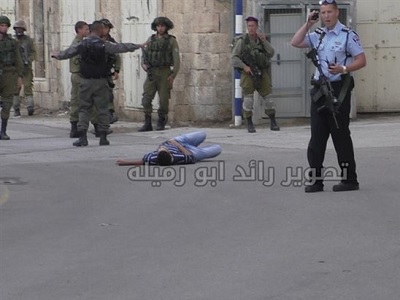
By Lama Khater
The events taking place in Hebron during this intifada may have led many to research and examine the reasons why the conflict in the city continues to escalate. The pattern of violence seems to be consistent with those found in other parts of the West Bank or absent altogether elsewhere.
Hebron is carrying the burden of the intifada and is the source of the struggle, but it is important to note that this is not a coincidence. It is the only place in the West Bank in which settlement expansion continues to grow in the heart of a Palestinian city. In fact, the settlements are entrenched in the liveliest parts of Hebron, which helps to explain why the Israeli army has a permanent presence there to protect the settlers who are not satisfied with living in the Jewish neighbourhood planted in the city centre. The settlers have expanded to maintain control of the area surrounding the Ibrahimi Mosque in its entirety. It has become a shrine that is filled with thousands of Jewish worshippers during the holidays, which prevents the Arabs in the city from getting to their cars. The city was divided between Jews and Palestinians as part of the Oslo Accords but, as of late, Hebron has come under the control of the occupation forces, which continue to harass the Palestinians and restrict their movement.
All of these factors can help to explain why Hebron is in a state of constant chaos, whether it is related to the question of settlement expansion or the violations committed by Israeli security forces in an effort to contain the population and maintain control. Through the uprising, Hebron has shown that it is confronting the occupation and that it has become impossible to live with the status quo. Remaining silent is not an option. The factors leading to dissatisfaction and revolution will continue to be prominent in this city. It is to be expected that these sentiments are reflected on the ground during this intifada.
Nevertheless, it appears as though the events in Hebron are linked to a sequence that has taken place since the outbreak of violence in May 2014, followed by Israel’s war against Gaza and the events of October of last year. The rage and frustration were renewed when the Dawabsheh family was burnt alive by settlers earlier this year. Soon afterwards, a wave of protests were organised by Hamas and the beginning of the Intifada seemed to be an expected outcome in the city. There are factors in this which are excusive to Hebron, and are unlike those in other West Bank cities.
The uprising has developed a more tribal characteristic which we have seen unfold as whole families take to the streets to go to Hebron’s mortuaries to retrieve the bodies of their martyred children. The people have been focusing most of their energy on mobilising the youth, which has lead the entire Palestinian community to participate in this intifada and accept responsibility for the revolution.
Hebron’s experience has showcased the people’s efforts to include a wide cross-section of the public, from all factions, and it must be replicated in the rest of the occupied Palestinian territories. It is not helpful for the struggle to be contained and limited to one area in a constant confrontation with the occupation at select points of contact. If it continues in this way, the struggle can weaken and fade out without ever nearing a successful conclusion.
A society of resistance that is suffering constantly from the bitterness of occupation must remain distinct and present. It is not beneficial for one faction to carry the burden of resistance, to fill the ranks of fighters and sacrifice its people all on its own. Since we are talking about a popular uprising and we are demanding that we maintain the current pattern of resistance, we must, in turn, demand that Palestinian society participates in the intifada en masse.
(Translated by Middle East Monitor from Felesteen, on November 02, 2015.)





I am from Vancouver,Canada and I wanted to say that I supports Palestinian Journalist, Lama Khater in her work to get the latest news on Palestine to people around the world.It will be Palestinian Women like her who will eventually free Palestine from Israeli Occupation.The whole world supports Lama Khater and other Palestinian Women fighting against Israeli occupation of Palestine.